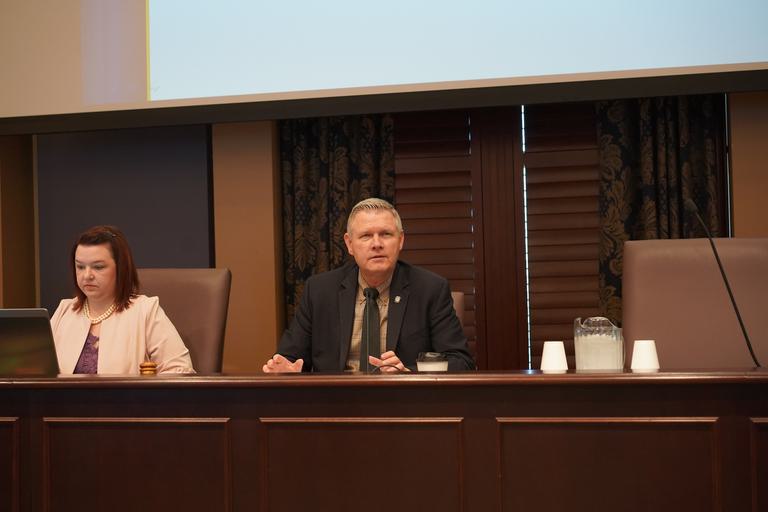
Education
Ray Carter | September 11, 2019
Experts: Many trade-offs with class-size limits
Ray Carter
Class-size limits imposed by passage of House Bill 1017 in 1990 are often cited as a major reform, but those limits have effectively been repealed for almost a decade now.
While some school lobbying groups continue to call for reducing class sizes, experts told members of the Senate Education Committee on Tuesday that class-size reduction is very expensive, the educational benefits are limited, and there may be more beneficial ways to spend taxpayer resources in schools.
“The research is not conclusive, across-the-board,” said Michelle Exstrom, education group director for the National Conference of State Legislatures.
Exstrom noted about half of the countries with high educational outcomes have larger class sizes than what is typical in the United States.
“We know that class size does not seem to be as big of an issue for them or as big of a concern for them,” Exstrom said. “They are highly focused on teacher effectiveness.”
That includes providing more development time for teachers in those countries, she said. Teachers in high-performing education systems around the globe often spend about half their time in front of students with the rest of their time spent reviewing data, working on assessments, and similar activity.
In contrast, the average U.S. teacher spends six hours a day before students.
“By far, the U.S. has the highest number of hours spent in front of students,” Exstrom said.
In other countries, she said multiple teachers often work with a class.
“We have trade-offs that we make here in the U.S.,” Exstrom said. “And as I mentioned, in these other, higher-performing countries, they have determined that their finite resources are better invested in a different way.”
The Senate Education Committee’s review comes as officials are debating whether and how aggressively to re-impose class-size limits in Oklahoma’s public schools.
Carolyn Thompson, chief of government affairs for the Oklahoma Department of Education, told lawmakers that prior to the 1990 passage of HB 1017, size limits ranged from 20 pupils per class in the K-2 grades and up to 36 in middle school with no limits for high school courses. HB 1017 lowered those figures to 20 students per class in grades K-6, while teachers in grades 7-12 were to have no more than 140 students in any six-hour block.
However, the law included a waiver for schools that were already at 85 percent of the bonded-indebtedness limit, based on the theory that smaller class sizes would require more classroom space, and schools that lacked bonding capacity could not provide the additional classrooms. That exemption covers many schools.
Furthermore, in the aftermath of the national recession in 2010, the Legislature placed a moratorium on assessment of school penalties for exceeding class-size limits, effectively suspending the law. That moratorium has been continually extended ever since, although class-size limits in the lowest grades may take effect again next year under current law.
Daniel Thatcher, education program director for the National Conference of State Legislatures, told lawmakers that research shows class-size limits have the most benefit when targeted to certain students in specific circumstances, such as low-income students in high-risk communities, primarily in lower grades.
He said lawmakers need to consider several factors before mandating lower class sizes.
“Is there a quality teacher pool?” Thatcher asked. “Are there adequate facilities to house classrooms?”
Failure to consider those challenges can lead to unintended consequences.
When California imposed class-size limits in 1996, Thatcher said “the need for teachers was apparent and a wave of teachers who were probably not qualified to be in the classroom came into the classroom, and California actually loosened its licensure for teaching.”
He said schools also struggled to find space to house new classes.
The challenge of finding quality teachers was stressed throughout the meeting.
“Obviously, we all recognize that we’re in a teacher shortage and specifically we have significant shortages in early childhood and elementary education,” Thompson said.
While the overall number of teachers has increased in the past year, Thompson said quality remains something “we need to take on with more vigor.”
Furthermore, she noted the teacher shortage issue is nothing new. Thompson pointed out that HB 1017 created a professional standards board. The law’s text specifically said that group’s work would include taking “notice of the increasing and critical role of the teacher in the education process and the current and projected shortages of teachers.”
Exstrom stressed that high-performing nations put great emphasis on teacher training and development, and indicated a focus on that area could yield greater benefits than simply reducing the number of students in public-school classrooms.
“We allow teachers to ‘practice’ on our kiddos, and unfortunately if they’re not ready to implement the skills … we’re seeing the results,” Exstrom said. “Our kids aren’t getting the kind of education that we know is so important to them, because we’re putting them in front of teachers that aren’t adequately prepared.”

Ray Carter
Director, Center for Independent Journalism
Ray Carter is the director of OCPA’s Center for Independent Journalism. He has two decades of experience in journalism and communications. He previously served as senior Capitol reporter for The Journal Record, media director for the Oklahoma House of Representatives, and chief editorial writer at The Oklahoman. As a reporter for The Journal Record, Carter received 12 Carl Rogan Awards in four years—including awards for investigative reporting, general news reporting, feature writing, spot news reporting, business reporting, and sports reporting. While at The Oklahoman, he was the recipient of several awards, including first place in the editorial writing category of the Associated Press/Oklahoma News Executives Carl Rogan Memorial News Excellence Competition for an editorial on the history of racism in the Oklahoma legislature.